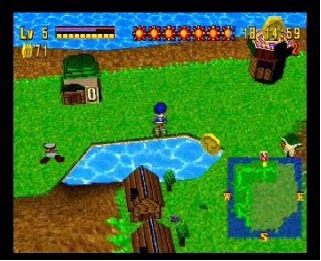|
|

|
PLATFORM
|
PSX
|
BATTLE SYSTEM
|

|
INTERACTION
|

|
ORIGINALITY
|

|
STORY
|

|
MUSIC & SOUND
|

|
VISUALS
|

|
CHALLENGE
|
Unbalanced
|
LANGUAGE BARRIER
|
Easy
|
COMPLETION TIME
|
Less than 20 Hours
|
|
OVERALL

|
+ Fun enemy designs.
+ Good for practicing math.
- Not really good for much else.
- Story is minimal to point of non-existence.
- Too easy to run out of cards in battle.
- Some math functions are tricky to use.
|
Click here for scoring definitions
|
|
|
At their core, most RPGs are about the numbers. Study Quest: Adventures on Math Island takes this a bit more literally. This little game for the PlayStation was produced by Shigakusha, a now-defunct company that specialized in home-study materials for elementary school students. Home-study is a lucrative business in Japan, so companies are always looking for an extra "in" with the kiddoes.
The game begins with a storm and a shipwreck, after which the player washes up on the shores of a strange new land. The islands of Arithmea were once home to a fabulous civilization, brought low by the evil Lord Random. The hero must wield the numbers that the citizens can no longer use, face down Lord Random's minions, and purge Arithmea of the evil that confuses it so. Oh, and the entire archipelago is doomed in seven days' time. While this might be a promising start to any RPG, here it constitutes the majority of the game's plot — without any further elaboration or contributions for the rest of the way through.
There are six grade levels to choose from, but the game plays out similarly for each. The player must navigate a series of randomly assembled islands, collecting magic tomes that correlate to specific arithmetic drills. Once all the tomes are found, the player can enter a tower to face the shadow of the island's master. By beating the shadow, the way to the island's castle becomes clear. The biggest difference between the grade levels is the variety of drills, which in turn affects the number of tomes to find, the number of isles in the archipelago, and the total time necessary to finish the game. To balance things somewhat, lower grades face more mini-bosses on each island while for higher grades the in-game clock progresses more slowly.
 If a werewolf's half man and half beast, does that make him naturally skilled at fractions?.
If a werewolf's half man and half beast, does that make him naturally skilled at fractions?.
|
|
Battles are frequent. Lord Random's "Numbermen" swarm all over the place, and even though the player can press the circle button to jump, that's usually not enough to evade them. In combat, the player's number cards function as hit points, equipment, and consumable items. To win a battle, a question or series of questions must be answered using the hero's number cards. At the same time, the enemy is attacking that same stock of cards. Since they're both consumable and damageable, it doesn't take long to exhaust the supply of numbers. Restock points are thankfully common, as are the trade coins needed to purchase more. As the hero gains levels, his or her maximum card limit increases, but early on it's quite possible to lose to a persistent enemy that requires the same answer too often. This is especially common in areas dedicated to greater-than or less-than drills. To help the player, some shops sell number back-ups or special defense cards, but the availability and locations for these are often too limited to be relied upon until late in the game.
The difficulty in this game is decidedly unbalanced in the higher grades. Even at the sixth-grade level, the player must start with simple greater-than drills. By the third island (out of seven), the game pulls out complicated four-digit subtraction problems with tight time limits and aggressive enemies. Then the remainder, decimal, and fraction equations begin — except that the function cards for those are never supplied directly to the player. Instead, they must be won via a trading game. The fraction function is made further annoying because it follows the Japanese method of input, which is opposite the Western method, i.e. instead of one-fourth, the Japanese write 4-bun-no-1, with the effective order of numbers reversed. In short, Study Quest's difficulty increases exponentially well before the exponents are even introduced.
 Just another day in the neighborhood.
Just another day in the neighborhood.
|
|
The visuals are a little better than might be expected, but they aren't terribly good, regardless. The islands and dungeons are randomly generated, with the normal recycling of graphics that this would entail. NPCs are seen by character portrait only. They're generic and forgettable in any case. The enemies are all polygonal models, and this is where the game's graphics are at their most memorable. The various Numbermen possess designs both amusing and interesting in spite of the blocky polygons used to create them. True to the kiddy nature of the game, enemies often resemble something out of Anpanman or other children's cartoon series from Japan. The major bosses are all memorably, and include a fiery djinn, a frost giant, a kung-fu girl, and an Elvis impersonator. Lord Random himself is actually rather imposing, and switches visual motifs (and attack types) every round as well. There's also a good deal of musical variety to be had, with different tunes for different islands, and distinctive themes for each boss.
In conclusion, Study Quest has some good points to it, but those hardly outbalance its flaws. This is a game designed for one purpose, and it does that purpose reasonably well, but beyond that it's hard to recommend. For someone in need of arithmetic practice, it might be a fun diversion, but for anyone else it will be alternately dull and frustrating.
Review Archives
|









